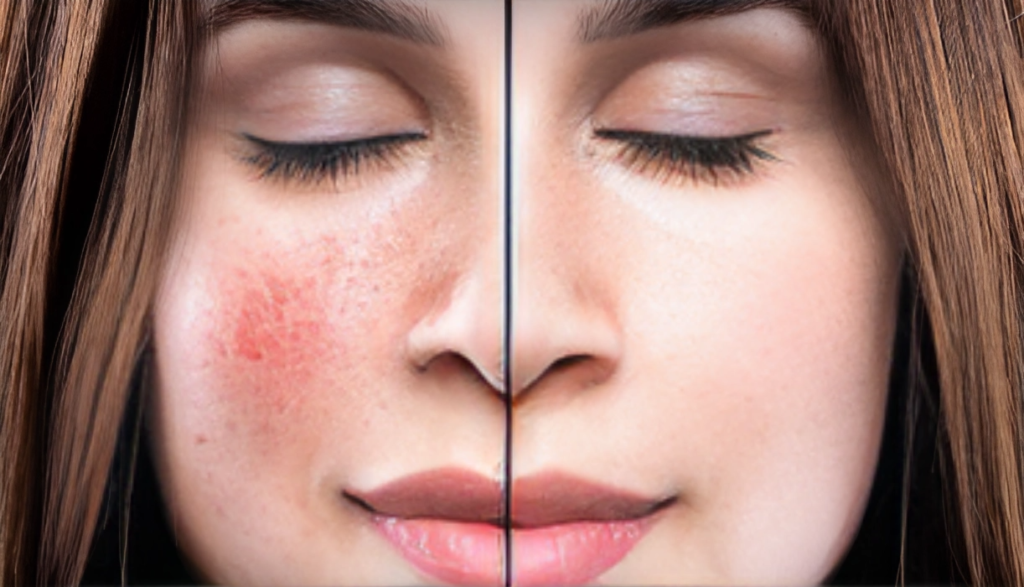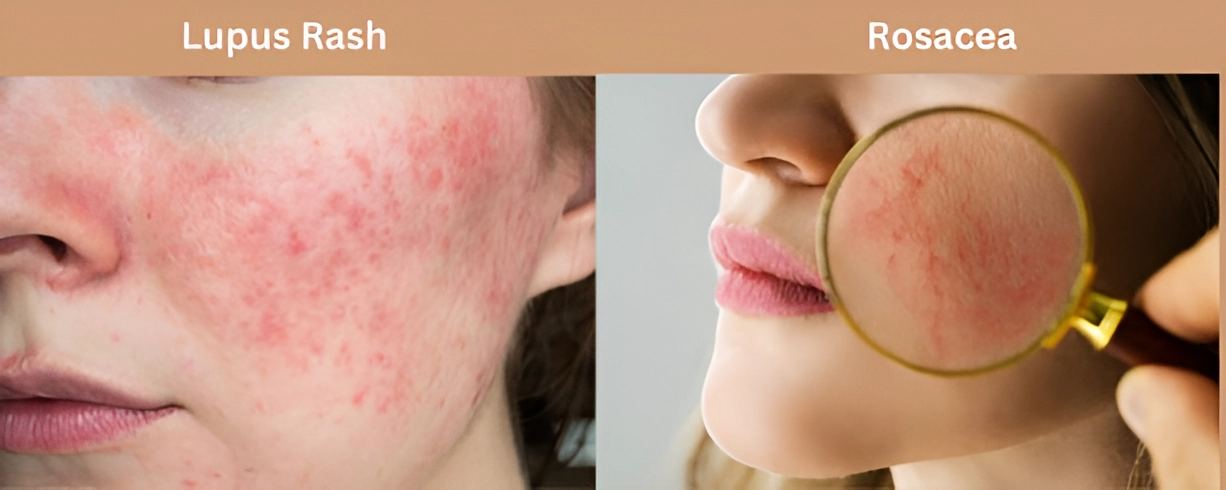Lupus rash and rosacea are two distinct skin conditions that can often be confused due to their similar symptoms. Lupus rash is a common manifestation of systemic lupus erythematosus (SLE), an autoimmune disease where the body’s immune system attacks healthy tissues, including the skin. On the other hand, rosacea is a chronic skin condition that primarily affects the face, causing redness, visible blood vessels, and sometimes small, red, pus-filled bumps. Proper diagnosis is crucial as lupus rash requires specific medical management, while rosacea treatments focus on symptom control and lifestyle adjustments.
Definition & Symptoms of Lupus Rash
Lupus, also known as systemic lupus erythematosus (SLE), is an autoimmune disease characterized by the immune system attacking healthy tissues and organs, causing inflammation throughout the body. A common sign of lupus is a butterfly-shaped rash on the face, which covers the cheeks and bridge of the nose. This rash is often triggered by exposure to sunlight and is a hallmark symptom of the disease. Lupus rashes can also appear on other parts of the body, and their appearance and severity can vary depending on the individual’s case.
Definition & Symptoms of Rosacea
Rosacea is a chronic skin condition that primarily affects the face, causing redness, visible blood vessels, and sometimes small, pus-filled bumps. It can be mistaken for acne or other skin problems. Rosacea symptoms may flare for weeks to months and then go away for a while. The condition can also cause eye problems, such as dry, irritated eyes and eyelids. Rosacea is not caused by poor hygiene and can be triggered by factors like sun exposure, stress, spicy foods, alcohol, and certain medications.
Lupus Rash vs Rosacea
| Aspect | Lupus Rash | Rosacea |
|---|---|---|
| Condition | Lupus rash is a symptom of systemic lupus erythematosus (SLE), an autoimmune disease. | Rosacea is a chronic inflammatory skin condition. |
| Underlying Cause | Autoimmune dysfunction, genetic predisposition, environmental triggers. | Vascular abnormalities, inflammation, skin barrier dysfunction, microbial factors. |
| Appearance of Rash | Butterfly-shaped rash across the cheeks and nose, may extend to other areas of the face. | Persistent facial redness, may resemble a sunburn or blush. |
| Distribution of Rash | Typically involves the central face in a butterfly pattern sparing the nasolabial folds. | Diffuse redness involving the central face, may spread to cheeks, chin, and forehead. |
| Texture of Skin Lesions | Rash may be raised, scaly, or have a discoid appearance. | Papules, pustules, visible blood vessels (telangiectasia). |
| Associated Symptoms | Joint pain, fatigue, fever, sensitivity to light, hair loss, organ involvement. | Flushing, burning or stinging sensation, eye irritation (ocular rosacea). |
| Triggers | UV exposure, certain medications, infections, hormonal changes, stress. | Sun exposure, spicy foods, alcohol, hot beverages, stress, harsh skincare products. |
| Treatment Approach | Immunosuppressant medications, NSAIDs, antimalarial drugs, symptom management. | Topical and oral medications (e.g., antibiotics, azelaic acid), laser therapy, lifestyle modifications. |
| Prognosis | Chronic condition with periods of flares and remission, variable prognosis. | Chronic condition with periodic exacerbations, typically not life-threatening. |
| Complications | Organ involvement (e.g., kidneys, heart, lungs, nervous system), increased risk of cardiovascular disease, blood disorders. | Ocular complications (e.g., dry eyes, corneal damage), psychological impact (e.g., social anxiety). |

Causes of Lupus Rash
- Autoimmune Dysfunction: Lupus rash is primarily associated with systemic lupus erythematosus (SLE), an autoimmune disease where the body’s immune system mistakenly attacks healthy tissues. In lupus, the immune system produces autoantibodies that target various organs and tissues, leading to inflammation and tissue damage. The exact cause of autoimmune dysfunction in lupus is not fully understood, but it likely involves a complex interplay of genetic predisposition, environmental factors, and dysregulation of immune responses.
- Genetic Factors: Genetics plays a significant role in the development of lupus rash. Certain genetic variations are associated with an increased susceptibility to autoimmune diseases like lupus. Individuals with a family history of lupus or other autoimmune conditions have a higher risk of developing the disease themselves.
- Environmental Triggers: While genetic factors predispose individuals to lupus, environmental triggers can precipitate disease onset or exacerbate symptoms. Common triggers include exposure to ultraviolet (UV) light from sunlight, certain medications (e.g., hydralazine, procainamide), infections (e.g., Epstein-Barr virus), hormonal changes, and smoking. These triggers can activate the immune system and trigger inflammatory responses, leading to lupus flares and the manifestation of symptoms such as the characteristic butterfly-shaped rash.
- Hormonal Factors: Hormonal fluctuations, particularly in women, can influence the development and severity of lupus rash. Estrogen, in particular, has been implicated in modulating immune responses and contributing to lupus pathogenesis. Hormonal changes during puberty, pregnancy, and menopause, as well as hormonal medications like oral contraceptives, can impact the course of lupus and may trigger flare-ups of the rash.
Causes of Rosacea
- Vascular Abnormalities: Rosacea is characterized by abnormalities in the blood vessels of the face, leading to flushing, redness, and visible blood vessels (telangiectasia). While the precise cause of these vascular changes is not fully understood, it is believed that alterations in blood vessel function and structure contribute to the development of rosacea. Factors such as increased blood flow, vascular hyperreactivity, and vascular remodeling may play a role in the pathogenesis of rosacea.
- Inflammatory Responses: Inflammation is a key component of rosacea pathophysiology, contributing to the development of redness, swelling, and papules/pustules characteristic of the condition. Chronic low-grade inflammation in the skin, possibly triggered by external factors, immune dysregulation, or microbial factors, may drive the inflammatory cascade seen in rosacea. Immune cells and inflammatory mediators are recruited to the skin, leading to tissue damage and the release of pro-inflammatory cytokines that perpetuate the inflammatory response.
- Dysfunction of the Skin Barrier: The skin barrier plays a crucial role in protecting against external insults and maintaining skin homeostasis. In individuals with rosacea, there is evidence to suggest that the skin barrier may be compromised, leading to increased susceptibility to environmental triggers and microbial colonization. Disruption of the skin barrier function can exacerbate inflammation, trigger immune responses, and contribute to the development of rosacea symptoms.
- Microbial Factors: Microorganisms, particularly certain bacteria (e.g., Demodex mites) and microbes associated with the skin microbiota, have been implicated in the pathogenesis of rosacea. Dysbiosis, or an imbalance in the skin microbiome, may contribute to inflammation, immune activation, and the development of rosacea symptoms. Additionally, microbial factors may interact with host immune responses and skin barrier function to exacerbate rosacea pathology.
Treatments for Lupus Rash

1. Medications to Suppress the Immune System
In cases of lupus rash, one approach to managing symptoms involves the use of medications aimed at suppressing the immune system. Lupus is characterized by an overactive immune response, where the body’s immune system mistakenly attacks healthy tissues. By dampening this immune response, medications help to alleviate inflammation and reduce the severity of lupus symptoms, including the rash.
These medications work by targeting various components of the immune system, modulating its activity, and preventing it from attacking healthy tissues. They are often prescribed during lupus flares to help control the autoimmune response and minimize tissue damage. The goal of immune-suppressing medications is to reduce inflammation, alleviate symptoms, and prevent complications associated with lupus rash and other manifestations of the disease. Treatment regimens may vary depending on the severity of symptoms and individual patient factors
2. Symptom Management
Nonsteroidal Anti-Inflammatory Drugs (NSAIDs): NSAIDs such as ibuprofen or naproxen may be used to alleviate joint pain and inflammation associated with lupus.
Antimalarial Drugs: In addition to hydroxychloroquine, other antimalarial medications like chloroquine may be prescribed to manage lupus symptoms and prevent flares.
3. Prevention of Flare-ups
Sun Protection: Sun exposure can trigger lupus flares, so it’s essential for individuals with lupus rash to protect their skin from UV radiation by wearing sunscreen, protective clothing, and avoiding prolonged sun exposure.
Stress Management: Stress can exacerbate lupus symptoms, so stress-reduction techniques such as relaxation exercises, mindfulness, and counseling may be helpful in managing the condition.
4. Other Therapies
Biologic Therapies: In severe cases of lupus that do not respond to conventional treatments, biologic therapies targeting specific components of the immune system may be considered.
Plasmapheresis: This procedure involves removing antibodies and other potentially harmful substances from the blood and may be used in severe cases of lupus with organ involvement.
Treatments for Rosacea

1. Topical Medications
Topical medications are applied directly to the affected skin areas to reduce inflammation, alleviate redness, and control the formation of papules and pustules associated with rosacea. These formulations typically contain active ingredients with anti-inflammatory and antimicrobial properties, targeting specific symptoms of rosacea. They are often used as a first-line treatment for mild to moderate rosacea and should be applied as directed by a healthcare professional for optimal results.
2. Oral Medications:
Oral Antibiotics: Oral antibiotics like doxycycline, minocycline, or erythromycin may be prescribed to reduce inflammation and control bacterial overgrowth associated with rosacea.
Isotretinoin: In severe cases of rosacea, isotretinoin (Accutane) may be prescribed to reduce sebum production and inflammation. However, it is typically reserved for cases that do not respond to other treatments due to its potential side effects.
2. Laser and Light Therapies
Laser Therapy: Various types of laser and light-based therapies, such as intense pulsed light (IPL) and pulsed dye laser (PDL), can target visible blood vessels and reduce redness associated with rosacea.
Photodynamic Therapy (PDT): PDT involves the application of a photosensitizing agent followed by exposure to specific wavelengths of light, which selectively target and destroy abnormal blood vessels and reduce inflammation.
3. Lifestyle Modifications
Avoiding Triggers: Identifying and avoiding triggers that exacerbate rosacea symptoms, such as sun exposure, spicy foods, alcohol, hot beverages, and harsh skincare products.
Gentle Skincare: Use gentle skincare products that are fragrance-free and non-comedogenic to avoid irritation and inflammation of the skin.
Sun Protection: Apply broad-spectrum sunscreen with a high SPF daily and wear protective clothing and hats when outdoors to minimize sun exposure.
4. Other Therapies
Botulinum Toxin Injections: In some cases, botulinum toxin injections may be used to reduce flushing and facial redness associated with rosacea by blocking nerve signals that cause blood vessels to dilate.
Surgery: Surgical procedures such as vascular laser surgery or electrocautery may be considered for the removal of visible blood vessels or enlarged nose tissue (rhinophyma) in severe cases of rosacea.
FAQs About Lupus Rash & Rosacea

How do I know if I have lupus rash or rosacea?
Lupus rash typically presents as a butterfly-shaped rash across the cheeks and nose, often accompanied by photosensitivity, joint pain, and fatigue. It may also involve other areas of the body. On the other hand, rosacea is characterized by persistent facial redness, visible blood vessels, and may include symptoms such as bumps and eye irritation. A healthcare professional can provide a definitive diagnosis based on a physical examination, medical history, and possibly additional tests or evaluations.
What does lupus rash on face feel like?
The sensation experienced with lupus rash on the face can vary among individuals. Some may describe it as a warm or burning sensation, while others may not feel any discomfort. In addition to the rash, individuals with lupus may experience other symptoms such as joint pain, fatigue, and sensitivity to sunlight.
What is the texture of a lupus rash?
The texture of a lupus rash can vary depending on individual factors and the specific characteristics of the rash. In some cases, the rash may appear flat and red, resembling a sunburn. However, it can also have a raised, scaly, or discoid texture, especially in cases of discoid lupus erythematosus (DLE). The texture may evolve over time and may be accompanied by other symptoms such as itching or tenderness. Consulting a healthcare professional for an accurate diagnosis and appropriate management is recommended.
What does a lupus rash look like?
A lupus rash often presents as a butterfly-shaped rash across the cheeks and nose, resembling the wings of a butterfly. It typically appears red or purplish in color and may be flat or raised. The rash may extend to other areas of the face and can vary in severity. In some cases, lupus rash may also involve other parts of the body, such as the neck, chest, or arms.
How long does lupus rash last?
The duration of a lupus rash can vary depending on factors such as the individual’s immune response, the severity of the lupus flare, and the effectiveness of treatment. Lupus rash may last for days to weeks during a flare-up, and it may resolve spontaneously or persist for a longer duration if left untreated. Treatment aims to alleviate symptoms and reduce the duration of the rash.
How to get rid of rosacea permanently?
While there is no permanent cure for rosacea, various treatments can help manage symptoms and reduce flare-ups. These treatments may include topical medications, oral medications, laser therapy, and lifestyle modifications. It’s essential to work with a healthcare professional to develop a personalized treatment plan tailored to your specific needs and to follow recommended skincare practices to minimize triggers and maintain skin health.
What does rosacea look like?
Rosacea typically presents as persistent facial redness, often resembling a sunburn or blush. The redness may be accompanied by visible blood vessels (telangiectasia), bumps (papules and pustules), and in some cases, thickening of the skin (rhinophyma). Rosacea can vary in severity and may involve different subtypes, including erythematotelangiectatic rosacea (characterized by redness and visible blood vessels) and papulopustular rosacea (characterized by bumps and pimples). It’s essential to consult a healthcare professional for an accurate diagnosis and appropriate management of rosacea symptoms.
What does a lupus rash look like?
A lupus rash often presents as a butterfly-shaped rash across the cheeks and nose, resembling the wings of a butterfly. It typically appears red or purplish in color and may be flat or raised. The rash may extend to other areas of the face and can vary in severity. In some cases, lupus rash may also involve other parts of the body, such as the neck, chest, or arms.
How long does lupus rash last?
The duration of a lupus rash can vary depending on factors such as the individual’s immune response, the severity of the lupus flare, and the effectiveness of treatment. Lupus rash may last for days to weeks during a flare-up, and it may resolve spontaneously or persist for a longer duration if left untreated. Treatment aims to alleviate symptoms and reduce the duration of the rash.
What does rosacea look like?
Rosacea typically presents as persistent facial redness, often resembling a sunburn or blush. The redness may be accompanied by visible blood vessels (telangiectasia), bumps (papules and pustules), and in some cases, thickening of the skin (rhinophyma). Rosacea can vary in severity and may involve different subtypes, including erythematotelangiectatic rosacea (characterized by redness and visible blood vessels) and papulopustular rosacea (characterized by bumps and pimples). It’s essential to consult a healthcare professional for an accurate diagnosis and appropriate management of rosacea symptoms.
How to get rid of rosacea permanently?
While there is no permanent cure for rosacea, various treatments can help manage symptoms and reduce flare-ups. These treatments may include topical medications, oral medications, laser therapy, and lifestyle modifications. It’s essential to work with a healthcare professional to develop a personalized treatment plan tailored to your specific needs and to follow recommended skincare practices to minimize triggers and maintain skin health.
In A Nutshell
Distinguishing between lupus rash and rosacea is essential for proper diagnosis and effective management. While lupus rash is a symptom of systemic lupus erythematosus, rosacea is a chronic skin condition with its own set of triggers and treatments. By understanding the key differences in symptoms, causes, and treatment options, individuals can seek timely medical attention and tailored care for their specific condition. Visual aids play a crucial role in diagnosis, aiding healthcare providers in accurately identifying lupus rash and rosacea, ultimately improving patient outcomes and quality of life.


